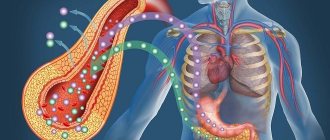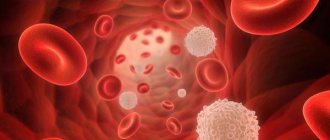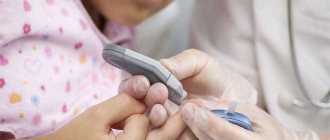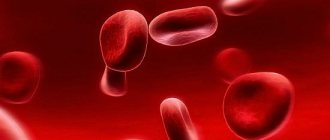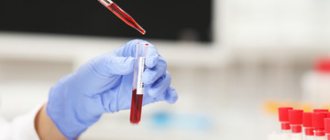The percentage of different types of leukocytes is called the leukocyte blood formula: decoding in children makes it possible to notice the development of pathology in time. A leukogram is drawn up when taking a clinical general blood test, and only a doctor can read it. But parents will also benefit from knowledge about what it is and how to understand certain medical terms.
What does a general blood test show?
Otherwise, a general blood test is called a clinical test and can be used to examine the composition of the blood. It can be shortened or expanded. A general blood test for children, the norm of which is established by WHO, is highly informative, since any disturbances in the immune system will certainly affect the composition of the blood.
Among the main indicators:
- hemoglobin – when it decreases, the patient experiences weakness and dizziness;
- reticulocytes - deviations from the norm indicate a disruption of the bone marrow, as well as renal failure;
- platelets - one of the main indicators, can reveal the inflammatory process and infection of any etiology;
- ESR – indicates the presence of infection in the form of ARVI, sore throat, influenza;
- leukocytes - in case of any deviations from the norm, it indicates serious pathologies from an allergic reaction to mononucleosis;
- plasma cells - detect viral infections, are elevated even in a child who has recently been ill;
- thrombocrit - this indicator indicates the tendency to thrombosis and bleeding;
- eosinophils - perform the function of protecting the blood from pathogenic microorganisms;
- basophils are a category of leukocytes that increase as a result of an allergic reaction, poisoning, or infection.
Norm and deviations
Leukocytes are very important blood cells that participate in immune reactions and protect the child from any negative influences. They form in the bone marrow and some other organs, and then enter the bloodstream and move throughout the child’s body. It is these cells that protect children from bacteria, viruses, toxins and many other influences. And therefore, a sufficient amount of them is important for maintaining the health of babies, and any changes in the number of white blood cells can be a sign of disease.
Leukocytes are normal - explanation in the table
To understand whether the child’s immunity is in order and whether the baby has any dangerous diseases, you should know what WBC indicator is considered normal. For children of different ages it will be like this:
In the first month of life
From 1 month to 1 year
From 1 year to 5 years
From 5 to 12 years
From 12 to 15 years
In children over 15 years of age
Increased rate
Also, leukocytosis is normal for several hours after eating, so the WBC blood sample should be given on an empty stomach.
An increase in WBC is characteristic of the following pathological processes:
- Bacterial infections.
- Acute surgical diseases.
- Chronic inflammatory processes.
- Viral infections.
- Allergic reaction.
- Fungal infection.
- Parasitic diseases.
- Autoimmune processes.
- Neoplasms.
- Severe bleeding or hemolytic anemia.
- Extensive burns.
- Injury
- Removal of the spleen.
- Leukemia.
Also, the WBC indicator may increase due to taking certain medications, for example, hormonal drugs.
We recommend watching a video in which the famous doctor Komarovsky answers questions about elevated white blood cells:
Below normal
If the WBC value decreases, the child is diagnosed with leukopenia. It occurs if the child:
- Exhaustion or hypovitaminosis.
- Poisoning.
- Bacterial infection.
- The viral disease is in the recovery stage.
- The bone marrow is damaged by chemicals, radiation, an autoimmune process, a tumor.
- Reduced blood pressure.
- Anaphylactic shock.
- Systemic disease.
- Diabetes mellitus or hypothyroidism.
- Increased spleen function.
- Tumor.
A decrease in WBC is also possible after treatment with certain medications, for example, cytostatics, anticonvulsants or antibiotics.
When is a test prescribed for children?
A general blood test in children, the normal value of which is important to constantly maintain, is prescribed to children for preventive purposes. This is the fastest, most accessible and effective research method through which you can determine the presence of the virus in the body.
There are several reasons why a pediatrician prescribes a general blood test:
- examination of the newborn - as a rule, on the 4th day after birth, blood is taken from the baby’s heel. This analysis makes it possible to exclude such hereditary diseases as galactosemia, phenylketonuria, hypothyroidism, cystic fibrosis and adrenogenital syndrome in the child;
- routine blood tests at 3, 9 and 12 months, then annually - in the first year of life it is especially important to monitor the child’s condition, since the risk of developing anemia is high;
- before vaccination - inflammation is a direct contraindication for vaccinating a child;
- bronchitis, acute respiratory infections, influenza or pneumonia - in this case, a general blood test will help prescribe the correct treatment and decide on the rationality of antibiotics.
Options for possible shapes and sizes
Red blood cells can take on different forms, which is how the pathology that caused the deformation is determined at the initial stage:
| Name of the modified red blood cell | Appearance in pathological condition | Possible reasons |
| Spherocyte | Ball, size reduced, no clearing visible. | Hemolytic anemia, transfusion of incompatible blood and plasma, disseminated intravascular coagulation, valve replacement, burns of anemic syndrome. |
| Annulocyte | Empty rings. | Iron deficiency. |
| Ovalocyte | Ellipse. | 10% of all red blood cells are in normal condition, the number increases due to thalassemia, leukemia, and hereditary ovalocytosis. |
| Codocyte | The color resembles a target (red dot in the center). | Cholesterol oversaturation, iron deficiency anemia, chronic alcoholism, hemoglobinopathies, DIC syndrome. |
| Acanthocyte | Serrated shape. | Liver pathologies, alcoholism, surgery to remove the spleen, hereditary acanthosis, hemolytic anemia. |
| Dacryocyte | Drip form. | Toxic hepatitis, severe VHD. |
| Leptocyte | Flat shape. | Iron-deficiency anemia. |
| Stomatocyte | The light part of the cell is shaped like the curve of a mouth. | After blood transfusions of inappropriate blood types or severe alcohol poisoning, cirrhosis of the liver. |
| Drepanocyte | Crescent shape, not visible in conventional analysis (artificial hypoxia on glass is needed). | Sickle cell anemia (main symptom). |
| Schizocyte, keratocyte | Small and large fragments of cells (no longer cells). | Severe anemia, vasculitis, DIC syndrome, malignant hypertension, hemolytic-uremic syndrome. |
| Echinocyte | Balls with protrusions. | Gastric cancer, liver parenchyma damage, hemolytic-uremic syndrome. |
Norms of indicators from birth to 18 years
The values of the indicators depend on the presence of the disease:
| Index | Age category | ||||
| 1 month | 6 months | 12 months | 2-5 years | 6-18 years | |
| Hb (hemoglobin, g/l) | 115-175 | 110-140 | 110-135 | 110-140 | 110-145 |
| RDC (red blood cells) | 2,8-4,9 | 3,5-4,8 | 3,5-4,9 | 3,5-4,5 | 4-5,2 |
| RTC (reticulocytes) | 0,25-0,9 | 0,2-1 | 0,2-0,6 | 0,2-1,3 | |
| PLT (thrombocytes) | 180-400 | 160-390 | 160-380 | ||
| ESR (ESR, mm/h) | 2-4 | 3-10 | 5-11 | 4-12 | |
| WBC (leukocytes, %) | 6-17,5 | 6-17 | 5,5-15,5 | 4,5-3,5 | |
| EOS (eosinophils, %) | 1-6 | 1-5 | 1-7 | 1-6 | 1-5 |
| LYM (lymphocytes, %) | 22-55 | 46-70 | 38-60 | 32-56 | 30-50 |
| MON (monocytes, %) | 5-15 | 4-10 | 3-10 | 3-9 | |
| BAS (basophils, %) | 0-0,5 | ||||
| MCHC (color index, %) | 0,85-1-15 | ||||
The results are interpreted by a pediatrician. Modern medicine performs tests using new technologies, so the results are more accurate than in previous years.
How to prepare for research
You should come for the examination on an empty stomach, preferably in the morning. However, drinking water is not prohibited. This rule does not apply to breastfed children, but it is still better to donate blood between feedings. If the baby is very stressed during the blood draw, you can put him to the breast at this moment. You must have a pacifier or water bottle with you.
If your child is taking medications that may affect blood counts, you should consult your pediatrician and, if necessary, stop taking them. In preschool age, an adult must accompany the child to the treatment room. It is not recommended to take a blood test immediately after a massage session, ultrasound or x-ray, or after physiotherapeutic procedures.
Signs of leukopenia and leukocytosis
Leukocytosis and leukopenia are not specific diseases, but symptoms indicating the presence of diseases. In the first case, the condition is asymptomatic; the following signs will indicate a problem:
- decreased appetite and weight loss;
- fever;
- increased body temperature;
- lethargy, fatigue;
- dizziness;
- increased sweating;
- sleep disturbance;
- fainting conditions;
- enlarged liver, lymph nodes, spleen;
- pain in joints and muscles.
Leukopenia itself also does not have any symptoms. But since this disorder involves the addition of an infectious agent, headaches, tachycardia, and swollen lymph nodes may occur. Therefore, parents should regularly check the normal level of leukocytes in their children’s blood.
How the biomaterial is collected
Most often, a general blood test is taken from a child’s finger. But if you need to get a detailed study, it is better to use blood from a vein. The patient's hands must be clean.
Blood sampling occurs according to the following algorithm:
- The fingertip is wiped with an alcohol wipe at the puncture site.
- Using an automatic scarifier, a puncture with a depth of 2-3 mm is made.
- The resulting drop of blood is collected with a glass pipette, applying light pressure on the fingertip if necessary.
- The resulting blood is poured into a special flask, and some is placed on a glass plate.
- At the end of the procedure, an alcohol wipe is applied to the puncture; you need to hold it for a while until the bleeding stops.
When collecting venous blood, the child’s forearm is tied with a tourniquet, and the vein on the inside of the elbow is pierced with a thin needle. The blood is collected in a flask. After the procedure, you need to keep your arm bent at the elbow for 3-5 minutes.
Description in UAC
Poikilocytosis is accompanied by a pronounced disturbance in the shape of blood cells; this condition is clarified in a general analysis using microscopy. First of all, the structure and type of red blood cell are determined.
Depending on this point, doctors describe the following possible options for poikilocytes:
- Ovalocytosis. Occurs in hereditary diseases. A change in shape like an ellipse is observed.
- Microspherocytosis. Spherical variety. Despite the relative normality, the sizes are significantly less than adequate.
- Anulocytosis. Lack of a dense middle of the cell. The structures have the shape of a ring.
There are also sickle-shaped, teardrop-shaped, target-shaped red blood cells and others. There are many options, the most common ones are named.
When assessing and interpreting the condition of red blood cells, the number of changed cells is also described.
Depending on this criterion, there are 4 degrees of the pathological process:
- Initial phase or mild poikilocytosis. Accompanied by a concentration of abnormal cells of 25-50% of the total. Not characterized by any symptoms. The violation is noticeable only by the results of laboratory analysis.
- Moderate or moderate disorder. From 50 to 70%. There is a mild clinic, there are no deviations yet.
- Pronounced variety. Characterized by a large number of altered cells. More than 70%.
- Critical phase. About 100% of abnormal red blood cells. It is relatively rare. For hereditary pathologies, congenital problems, malignant tumors of the hematopoietic system, etc.
Poikilocytosis in a general blood test can be expressed as a percentage (described above), numerically in points (1, 2, 3, 4), verbally expressed, or indicated using pluses (+). For clarity, the data is shown in the table:
| Degree of poikilocytosis | Points | (+) |
| Lightweight | 1 | + |
| Moderate | 2 | ++ |
| Expressed | 3 | +++ |
| Critical | 4 | ++++ |
Despite the general disorder and tendency to worsen, symptoms vary among patients. Even the 4th degree of the disorder does not always cause deadly complications. It all depends on the characteristics of the body and its adaptive capabilities.
How long to wait for research results
A general blood test for children, the norm of which is approved by WHO, is done within 1 to 3 working days. This does not include weekends and holidays. If the analysis was carried out in a public clinic, the results can be obtained from the local nurse or pediatrician.
In private clinics, test results can be printed on the website of the medical institution or collected from the place where the blood was drawn. In addition, it is in paid clinics that there is a service for urgent results. You can get a transcript of the analysis within 2 hours, but for an additional fee.
How to get tested
In order for the general analysis to be reliable, it is necessary to prepare for blood donation. The most important condition is that the test must be taken on an empty stomach. If adults can not eat for more than 12 hours, then it is difficult for children to withstand such a period, so they can eat in the evening, but in the morning blood must be donated before breakfast. Blood is taken from infants 2–3 hours after the last feeding, that is, as late as possible after the last meal. Additional condition for donating blood: a calm, balanced state. The baby should be relaxed. It is important to eliminate any stress.
The child should not engage in any activities before the analysis. You should also refrain from taking certain medications (antibiotics, anticonvulsants) for several days, unless they are vital. In newborn children, blood is taken from the heel, in older children - from the finger.
WBC analysis is prescribed in the following cases:
- during a preventive examination;
- with exacerbation of chronic diseases;
- before vaccination;
- before upcoming surgical interventions;
- to confirm or exclude an infectious disease.
It is not always necessary to rely on the results of the first analysis; if the results are higher or lower than normal, a repeat examination is most often prescribed. If the values are confirmed, further examinations can be carried out to confirm the diagnosis.
source
Decoding analysis responses
A general blood test is a mandatory type of diagnosis for many diseases in children, and the results of the study may even indicate such serious pathologies as cancer.
In addition, when deciphering the analysis, pay attention to the norm:
- red blood cells - if their level is reduced, we can talk about anemia and vitamin deficiency, while an increased level means the presence of chronic diseases;
- hemoglobin - an increased level can mean disturbances in the functioning of the heart, its defects, increased blood density and its diseases, and a reduced level is a direct sign of anemia;
- platelets - a high value is a consequence of the inflammatory process in the child’s body, and there is also a possibility of tuberculous changes; low platelets can occur in premature infants;
- leukocytes - their high level indicates the presence of infection or leukemia in the newborn, and the cause may also be stress or poor diet. A decrease in white blood cells may indicate infection, radiation sickness, allergies or exhaustion of the body;
- ESR – an overestimated value is possible with kidney pathology, anemia and the presence of inflammation, and a decrease is a sign of depletion and lack of nutrients;
- neutrophils - their decrease is the result of infection, dystrophy or exposure to radiation, and an overestimated number indicates an inflammatory process, a serious disease of the circulatory system;
- monocytes - increase due to malignancy, heart problems, tuberculosis and the presence of a virus in the body, and monocytes decrease as a result of such serious diseases as leukemia, radiation sickness and bone marrow pathologies;
- eosinophils - a high level is typical in the presence of lichen, skin dermatitis, parasites, as well as in acute allergic reactions. A low rate is likely due to a bacterial infection;
- basophils - their norm may be overestimated due to leukemia, thyroid diseases, anemia and malfunctions of the intestines and stomach;
- plasma cells - exceeding the norm is a symptom of measles, chickenpox.
When interpreting the results and making a diagnosis, you should not limit yourself to clinical analysis; it is necessary to take into account the accompanying symptoms of the disease. In addition, during treatment you need to take a general blood test several times.
Symptoms
The clinical picture depends on the stage of the pathological process and the individual adaptive capabilities of the body.
Typically, the manifestations are:
- Dizziness. It becomes the result of involvement of the extrapyramidal system, in particular the cerebellum, in the deviation. The episodes are regular and intense. The patient is forced to take a supine position to relieve the symptom.
- Neurological diseases. Focal disorders. The result of insufficient blood circulation in cerebral structures. Determined by a group of changes, depending on the location. Problems with hearing, vision, sensitivity, paresis, speech and articulation disorders and many other options.
- Heart rhythm disturbances. Like tachycardia, when heart rate increases. Fibrillations and the appearance of extrasystoles—extraordinary beats—are also possible.
All of these options initially pose a danger to health and even life. Restoring the normal functioning of the organ in the presence of symptoms is a priority task.
- Disorders of the cardiovascular system in general. Such problems are caused by insufficient nutrition of the myocardium and a decrease in the quality of blood circulation.
- Emotional and mental disorders. Irritability, aggressiveness. The most negative personality traits are emphasized.
- Weakness, asthenic syndrome. Inability to perform daily duties and work.
- Dry skin.
- Hair fragility.
- Fall in blood pressure. Usually minor.
- Fluctuations in body temperature. Up to 37-38 degrees Celsius. Rarely higher.
- Dyspnea. Especially under mechanical loads. Physical activity becomes at first extremely difficult, and then completely impossible.
Poikilocytosis manifests itself in the cardiovascular, central nervous systems, and other structures of the body. This is a generalized disorder.
There are two reasons for such a large list of symptoms. On the one hand, red blood cells are not capable of carrying oxygen due to their irregular shape. On the other hand, CO2 is transported from tissues as a waste product.
What could affect the validity of the study?
Preparation for a general blood test is necessary and requires specific rules listed above.
In addition to them, the following factors may affect the reliability of the study:
- physical activity – these should be avoided during the day before blood sampling;
- stress and nervous tension;
- time of day - it is better to take tests in the morning;
- taking medications;
- the dinner before the morning blood donation should be light, since excessive consumption of fatty foods leads to excess fat in the blood and impaired test results;
- within 2 hours it is not recommended to carry out physiotherapeutic procedures, as well as ultrasound, x-rays and massage;
- It is better to be at rest before donating blood.
Danger of condition
The life cycle of a healthy red blood cell is 120 days - from the moment it leaves the red bone marrow until death in the spleen. Changes in the shape of red blood cells are often caused by changes in its cell membrane, accumulation of harmful ballast substances inside the cell and dysfunction of the respiratory pigment - hemoglobin. Deformed cells bind oxygen worse, “wear out” faster and die. Modified red blood cells lose their elasticity, which prevents them from participating in microcirculation - supplying oxygen and removing carbon dioxide from distant areas of the body.
To replenish the natural need of the body's cells for oxygen, compensatory mechanisms are activated. An additional flow of oxygen is provided by rapid breathing and heartbeat - hence shortness of breath in heart failure, heart pain, pallor and cyanosis (blue discoloration) of the skin, dizziness and fainting. However, such compensation mechanisms are not able to fully compensate for oxygen deficiency, tissue nutrition deteriorates, health changes increase and require medical intervention.
What to do if there are abnormalities in the child’s general blood test?
After receiving the test results, the doctor must identify the pathology, make a diagnosis and prescribe treatment. Each item will indicate the likelihood of a particular disease.
Red blood cells
With their increased content, the blood becomes thick and viscous, which significantly reduces circulation. This may be accompanied by headaches, loss of consciousness and bleeding of the nasal mucosa. Serious illnesses such as pneumonia, kidney disease, asthma and heart disease may pose a risk.
It is worth paying attention to the level of reticulocytes, since its growth in dynamics means that the balance of red blood cells is restored. Otherwise, a consultation with a pediatric hematologist is necessary, who will determine the nature of these disorders.
The opposite concept of erythrocytosis is erythropenia. This is a decrease in the level of red blood cells, and probable diseases may be anemia, vitamin deficiency, poisoning and the presence of malignant tumors.
To prevent erythrocytosis, you need to give your child only purified water, because tap water, due to its high chlorine content, helps increase red blood cells. Fresh vegetables and fruits must be present in a child’s diet; they help the formation of new, healthy red blood cells.
To reduce the level of red blood cells, you need to eat beans, raisins, spinach, cereals, prunes and cabbage. The child also needs daily walks in the fresh air.
Hemoglobin
This indicator is very important for a child’s body; its deficiency can affect brain development. Oxygen starvation occurs, which cannot but cause a number of diseases. Statistics say that about 50% of preschool children suffer from anemia.
This is fraught with delayed mental and physical development, skin problems, and disruption of the immune system. In order to detect low hemoglobin in time, it is better to take a general blood test every 3 months.
Basic recommendations for maintaining normal hemoglobin levels:
- You should not give your child vitamin complexes without analysis and consultation with a pediatrician;
- Your diet should include fresh vegetables, fruits and nuts every day;
- It is better to breastfeed for at least 1 year;
- daily walks in the fresh air for 2-3 hours are required, and the child must also be provided with physical activity;
- It is necessary to exclude semi-finished products, food waste in the form of sauces and carbonated drinks from the child’s diet.
Changing the color index
The color index determines how filled the red blood cells are with hemoglobin.
As a result of the analysis, there can be 3 options for the color indicator:
- hyperchromic - a clear sign of anemia, vitamin deficiency, malignant tumors;
- normochromic;
- hypochromic - detected as a result of blood loss, anemia.
The normal color index for children under 3 years of age is from 0.75 to 0.96. After 4 years from 0.8 to 1.
You should not draw conclusions regarding the diagnosis based solely on the color indicator.
Leukocytes
When the white blood cell count is elevated, we are talking about leukocytosis. However, a slight increase does not necessarily indicate a serious illness.
This could be the result:
- complementary foods;
- long exposure to the sun;
- stress;
- physical activity.
White blood cells increase when any changes have occurred in the body. That is, they act as a protective barrier. If the level of leukocytes is exceeded by 2-3 times, we are talking about pathology.
The worst situation is caused by a low level of white blood cells. In 90% of cases, this indicates a disease that requires treatment. With rare exceptions, the decrease in white blood cells can be stopped with diet. But more often we are talking about an infection that can only be cured with medications.
Sufficient independent ways to eliminate leukocytosis are:
- proper, balanced nutrition;
- day and night mode;
- daily walks;
- hygiene procedures.
Leukocyte formula
A general blood test in children, the normal interpretation of which is an important diagnostic stage, shows the quantitative state of leukocytes. To do this, an extended analysis is carried out with a leukocyte formula, which makes it possible to accurately determine for what reason the indicators are impaired.
There are several types of leukocytes:
- neutrophils are an important element, perform a protective function, detect pathological bacteria and destroy them;
- basophils – prevent the spread of toxins through the circulatory system;
- eosinophils – protect the body from parasites, participate in allergic reactions;
- lymphocytes – destroy harmful cells, including cancer cells, and prevent the infection from progressing;
- monocytes - participate in the destruction of pathological and harmful cells.
If there are deviations in the leukocyte formula, the following should be done:
- pediatrician recommendations;
- consultation with a hematologist;
- correction of nutrition and drinking regime.
Platelets
The main task of these blood cells is to prevent bleeding. An elevated platelet count is referred to as thrombocytosis.
It may occur due to:
- past infection;
- lack of iron in the blood;
- acute infection of various etiologies;
- surgery, inflammatory process;
- taking certain medications.
A low platelet count is called thrombocytopenia. This condition is more dangerous and is fraught with severe blood loss. In case of such a pathology, an urgent visit to a hematologist is required, who will prescribe treatment.
In addition, if the platelet count is critically low, a blood transfusion may be required, and medications that restore normal platelet counts may be required.
ESR
The erythrocyte sedimentation rate indicates the presence of inflammation in the body.
An increase in ESR may be due to:
- infectious disease;
- bleeding;
- allergies;
- disruption of hormones;
- thyroid diseases;
- malignant neoplasm.
General blood test in children. ESR is normal
If the child is breastfed, the ESR may increase due to teething, vitamin deficiency, and also due to the mother’s poor diet.
To restore the ESR level, a complete examination of the child will be required, namely:
- blood test for biochemical composition;
- blood sugar level test;
- hormonal examination;
- stool analysis to identify parasites;
- fluorography or x-ray;
- Ultrasound of the digestive organs and spleen.
As a rule, the pediatrician prescribes a course of antibiotics, antiallergic drugs, and antiviral drugs. You should include fiber in your diet every day.
Treatment
Normalization of the level of leukocytes in the blood of a newborn or older children is carried out using conservative methods, namely:
- taking medications prescribed by a clinician;
- following a special diet - it is necessary to include in the menu foods that increase or decrease the level of white blood cells;
- the use of traditional medicine recipes - this can only be done after the approval of the attending physician.
However, it is worth noting that such measures will be ineffective if the underlying illness is not treated.
Therapy is purely individual, but may include:
- conservative;
- operable;
- complex.
In any case, treatment should be strictly supervised by the attending physician.
Where is the research conducted?
A general blood test can be taken not only in public medical institutions, but also in private clinics, but the service will already be paid. Due to the imperfection of state medicine, modern patients prefer private medical centers, their advantages are as follows:
- almost complete absence of queues, since registration is made in advance, strictly on time. This is the main criterion for the working population, because in a public clinic it is difficult to predict how long the test will take;
- You can take a clinical blood test on your own initiative, without a referral from a pediatrician;
- quick results - literally within 1 day you can get a transcript of the analysis with a detailed analysis of each indicator;
- high accuracy of the result - in most private clinics, the latest technology is used to analyze biological material.
The most popular clinics for taking a general blood test are:
- Invitro is a medical center operating in 290 cities of Russia; clinics are equipped with new European equipment. Invitro provides a blood collection service with a visit to the patient’s home, this is convenient for mothers with children. The patient is notified of the readiness of the test via SMS no later than 1 day after the test;
- Hemotest is a clinic with 300 branches throughout the country, the test result can be obtained in any convenient way (by fax, mail, in your personal account on the clinic’s website);
- Citylab is a clinic with offices in 86 cities of Russia; the institution provides discounts for certain categories of citizens.
You need to choose a medical institution for a general blood test based on location. Because during a trip to a remote clinic, the test result and normal indicator may be incorrect due to the child’s hypothermia, stress or physical exertion.
Article design: Vladimir the Great
What to do if the WBC indicator changes
As soon as the doctor makes a diagnosis and prescribes the necessary treatment for the child, as the baby’s condition improves and he recovers, the level of white cells in the blood will also normalize.
When leukopenia is detected in a child, it is important to find out its cause as soon as possible, since a low number of white cells in the blood indicates a decrease in protective forces and a high risk of contracting an infection. After determining the cause of low white blood cells, treatment should be started immediately, during which the WBC indicator will return to normal.
We recommend watching a video prepared by the Union of Pediatricians of Russia, dedicated to clinical blood tests:
